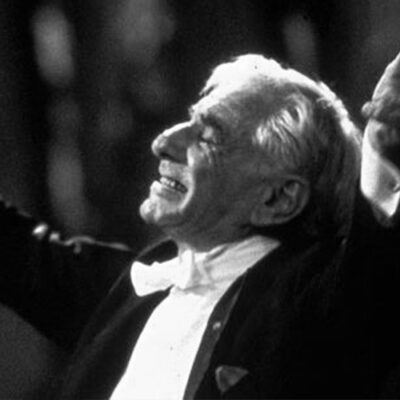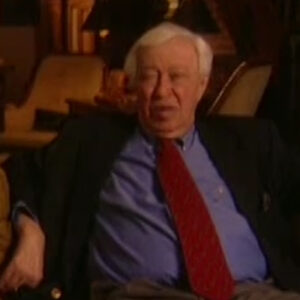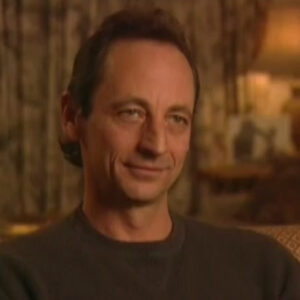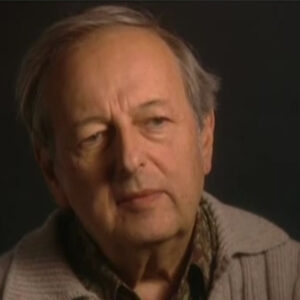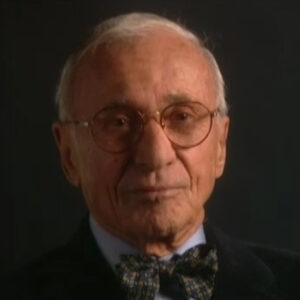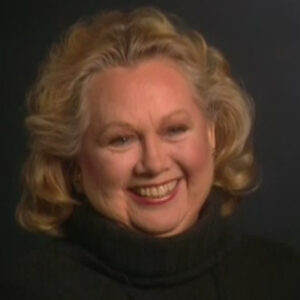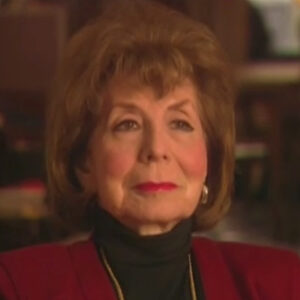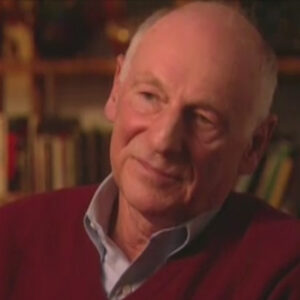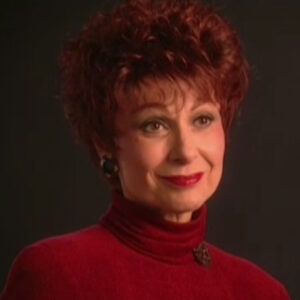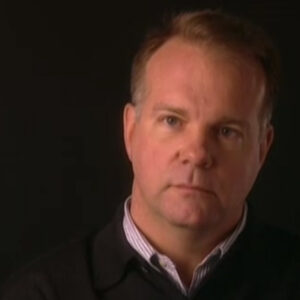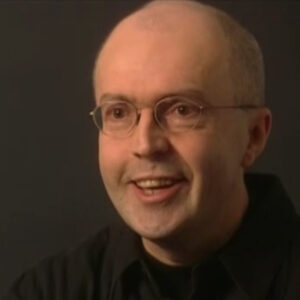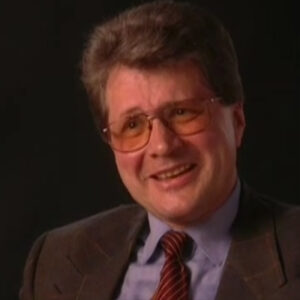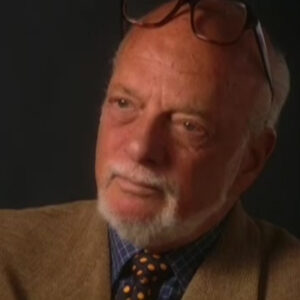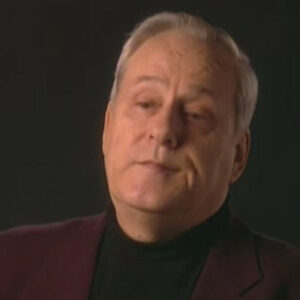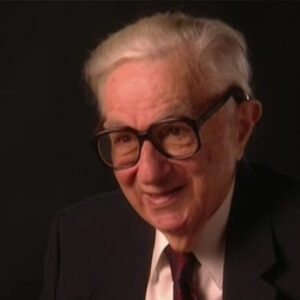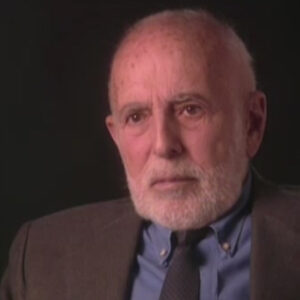Speaker How do you get to know Lenny and I get to know, actually. Besides growing up, watching him do young people’s concerts and being there and being, you know, a force in in young people’s lives, I think what kind of force was he in your life? Well, he just seemed to make classical music accessible.
Speaker And you wanted to hear it because you were hearing it through his eyes and ears. And and so if you had any appetite for it, he knew how to. Awaken it, but the.
Speaker The.
Speaker I went out to California in 1964 to to assist John Houseman on a production of King Lear at UCLA. It was a professional theater on the campus and before I could get out of town, they asked me to run the theater and I had to quickly make that decision and set up.
Speaker Apartment, find the doctor, because my wife was pregnant and about a seventh month at the time and in a hospital and stayed and a good friend of mine from from New York was Marie Perez.
Speaker And Marie had been the. One of the assistant conductors in that program that Lenny had, it was the year I think of, say, Seiji Asala, Moreese and one other. Young man, and so Morris got to know Lenny, I got to know Morris because I was a stage manager at the Phoenix Theatre downtown on 12th Street, and David Cameron was making a lot of music down there. And and Morris was a horn player. And we recorded all the music for the shows that we did and got to know Morris. And it was with Morris that I started to direct in opera in what I would call highly stylized, low budget versions of. Trying to make peace is dramatic and hopefully fulfilling and not about scenery and costumes, and we did an opera down at NYU. Morris was teaching there called A Barrier with a score by John Meyerowitz and text by Langston Hughes. Interesting piece. Actually, Langston had written a play called Mellado, and that was on Broadway in the mid 30s.
Speaker I think 35, maybe 38.
Speaker And the interesting thing about it was that the miscegenation and and the blacks in the company weren’t invited to opening night, and that’s where we were at that time. The actors couldn’t come to their own opening night party. And the play was a kind of steamy play that caused a lot of controversy but had something of a run. And then the composer named Maya, which turned it into an opera and it’s called the Barrier. And I staged it in NYU using very simple platforms and actually made the singers sit down and read the libretto before they started to sing, because I found suddenly that they had no idea not only what they were singing about, but what anybody else was singing to them with them. And it was an eye opening experience for me as a young fledgling director. And I’ve used that technique many times since to try to deepen the dramatic aspects of of, uh, of an opera, operatic work or musical theater piece. Maurice went to Corpus Christi, became music director there. I went down and did a number of operas there, cosy and a and a Carmen and a Bohem with singers from the New York City Opera who were wonderful and young John Rearden and Frank Paretta and people like that.
Speaker And, uh, and were willing to take chances, willing to sing lying down or standing on their heads or something. And we we found a way to tell those stories and very simple. I then went to California in 64 and this first period was all 58. Sixty two or three. And then Morris called me one day and we were always trying to find the next project and he said, hey, I would I’ve been looking at the score for Candide and it never gets done.
Speaker And maybe I could come down and do it, you know, in Corpus Christi and under the same format, I said, why don’t you come here to California? Because maybe we have access to, you know, some more singers. And and it’s really a you know, a theatre piece, not an opera.
Speaker And.
Speaker We started to work on we we tried to formulate an idea and then Lenny didn’t pay much attention to it, except that he gave Morris access to his trunk and it was in the trunk. We found some stuff that had been cut in Boston, particularly a wonderful ballad called Nothing More than This, which for some reason I think is the key to the dramatic linchpin of the piece.
Speaker And I used it I used it a couple of times in some productions have used it, but others haven’t. I never figure out why they don’t because it’s so important to the piece. It’s a it’s the moment when Candide finally realizes that Cunegonde is a whore and that she isn’t the, you know, the idealized virgin that he saw, that he’s traipsed all over the world and he confronts her with us in this gorgeous ballad. And the reason they cut it out of Boston is that they were trying to make it work as a as a as a show. And it seemed they wanted to get and it was eleven thirty already and they wanted to get people home. But it’s crucial because he sings that and he kind of throws money in her face and walks off to Westphalia and she follows and the other people follow and out of that comes make your garden grow.
Speaker So I knew it was well we did it and Lenny came to the dress rehearsal.
Speaker And of course, everybody was very nervous and came the moment of that ballot and he dissolved into tears.
Speaker So we dissolved the tears. And it was a great triumph. And it actually led to my getting the job at the music center, at the market bar for him. So it was very pivotal in my life.
Speaker And we did it very simply with a lot of emphasis on costumes and storytelling, and what I did was I reinserted a lot of Voltaire, which had been, you know, that that original production, which was amazing in one respect and a disaster, and others, I mean, have all the best people working on it. Tyrone Guthrie and Sheriff Smith with all those powerhouses.
Speaker Nobody talked as I best heard. Nobody ever talked to each other. They were so being so both in one hand respectful and on the other hand, you know, not deigning to talk to. They didn’t collaborate. They kind of each did their thing and.
Speaker You know, I mean, I wasn’t there for any of it, but it clearly. It was a piece that went into the culture as a as a almost as a cult piece, and people would be proud of their records if they were all, you know, scratched up from use because people knew the music and it was an enormous success.
Speaker And at the Rose and UCLA and and as I say, Mrs. Chadwick came to see it and offered me the job of opening it. But it was the relationship that started there with Lenny. The other relationship that didn’t start was that we were doing it.
Speaker Because I was introducing material and there was no script to work from except a concert version that had gone around the country, which was not really the script of the one, the didn’t know this long before.
Speaker However, even with interest in it, this was a direct outgrowth of the Broadway show.
Speaker And for people, Max, Adrian and Barbara Cook and Erit Petina and Robert Brownsville went around in tuxedos and, you know, and did the concert version occasionally.
Speaker So I was using a concert version and the Broadway script and stuff I found and I kind of shaped it would have, you know, in order simply to tell the story.
Speaker And I had a wonderful doctor, Pangloss, who I made Voltaire.
Speaker So Voltaire became Pangloss, and that was the then unknown, Carol O’Connor. And so and with wonderful design and MPRDA Wexler, we did it and.
Speaker That began a relationship, but after we had close, we only did it for 13 performances, plus some a couple more extensions.
Speaker I got a message from Lillian Hellman saying, I hear you’ve done a production of Candy, that we had billed it as a concert stage concert version, but it was more than that, if the truth be known. And she said, I I’d like to see the script. So I sent it to her and.
Speaker A few weeks later, a note came back and I cannot find that note in my files, I give anything to find it, it said something like this obviously shows the work of a talented director.
Speaker But let me make it very clear. No one, I repeat, no one has ever changed a word of mine in any script, and no one ever will just remember that.
Speaker And that was the end of that. But I wasn’t doing that anymore. And we were, you know, this past.
Speaker And I actually met her years later and kind of laughed about it a little bit. But that began a relationship with Lenny, which in 66, which I guess just five years later in 71 or so before we leave, that is when he then came out to, I guess, check out, not because he cared about it, but I think he’s worried about Lilyan, right?
Speaker No, no, he he. You mean when he came to see it, you know, he came to see because he wanted to see it, especially because we had put musical material back in the show and. He was he had no idea what he was going to see, and it was much more elaborate than than we ever initially when I learned that it was going to be.
Speaker And he but he was willing to look the other way because he was hearing the score very well sung and very well, you know, acted and put together a great deal of energy. And the guy that had the toughest time, and it was Morris because because he was conducting it and he was right on top of them, as Lenny could be, and and good and fast and, you know, making changes, you know, within minutes of performance.
Speaker But. He helped, you know, kind of put this little touch on and and he was, you know, thrilled and he said, don’t ever tell Lillian. And off he went back to New York and but we, you know, kept in touch.
Speaker Did he talk to you at that time on that trip out there about his hopes for Candy, what he how he felt about it later referred to it as the stolen shoe and the stepchild that he had to keep coming back to and getting attention to talk to you about at that time about that, Candy, what he’s trying to say. What he was trying to say with it was important, I mean, besides musically well.
Speaker Well, I mean, it’s a brilliant score and.
Speaker And he probably, as in many things, was probably trying to say too much, no, he never talked about it too much in terms of the genesis of it or anything like that.
Speaker But what I was able to observe is that first and foremost, musically, it was both a spoof and a kind of loving homage to operetta and and and he made a lot of musical tributes. You know, the jewel song, Glitter and Be Gay is a direct, you know, reference to the jewel song, pieces like that.
Speaker But and a great satirical piece of writing on Voltaire’s part at a time when. Um.
Speaker You know, in the 50s, there was a certain sense of optimism which was being cooled by the Cold War and by, you know, postwar optimism was also being the tension between that and the potential annihilation of the world.
Speaker I think, you know, concerned him. And so he tried to.
Speaker Write a piece which in the end, as he always tried to do, I think, give people a sense of hope.
Speaker I mean, make your garden grow. There’s a land somewhere in West Side Story. You know, the corral and mass keep reappearing as a as very important form.
Speaker But he he worked towards so but and I think the frustration of it was that how hard it is to make that peace work. And it did keep getting done again. And then how kind of reinvented it with the Chelsea Theatre production, which he made environmentally and was enormously successful. I think musically, it was never he was never happy with what happened to it because the emphasis wasn’t on the music there. And I tried very hard to balance the two, but I was working in a different arena totally. I mean, I respect him tremendously. And and he did give Bredon life. And then they try to convert that to Opera House version I. Glennis dream, I think was to just keep it in the repertoire.
Speaker It was more important that it be that and sung well than it than it was to be a successful Broadway show. I think he was past that. And of course, I think his greatest moment with it was when he himself finally conducted it many years later in England with opera singers Jerry Hadley and.
Speaker What’s your name?
Speaker June and June, Anderson, and and.
Speaker Adolph Green being an outrageous pandavas, but but if you see that tape, you see Lenny and absolutely in his element, you know, really living every minute of that. And he was very sick, too, I think, when he conducted. Thank you.
Speaker You’ve just done what I think. You’ve just done what I did. You just help me figure out how to deal with Candy. And I mean, it’s so complicated and there’s so many just that it so wonderfully.
Speaker Beautifully. Thank you.
Speaker Oh, it’s it was crucial to me. It was also haunted me because I think what happened was after I did it, you know, then he began to really think, oh, maybe it could be revived and how do we do it? And Roger Stevens wanted to do it and for good reason, which I never knew.
Speaker And I don’t know if he knew. They put together a production.
Speaker There was another kind of experimental production done in Chicago by Sheldon Patinkin, and that one suddenly became the one that they try to move it towards Broadway by remounting and mounting it with the Civic Light Opera and Los Angeles and and San Francisco. And then it was going to go to the Kennedy Center and to Broadway and it got into trouble.
Speaker And he called me and asked me to come up to San Francisco to see it.
Speaker And I think it was there that the seed for the mass was planted, that he was beginning to think about the mass. It didn’t know quite where it was going. Talk to me a little bit about it. I don’t remember the conversation exactly, but it was clear to me that, Candy, that version of Kennedy wasn’t going to work and there’s was nothing he could do about it.
Speaker And nothing I could do about it was just to be supportive. But out of that came one more step. And in our relationship of kind of mutual respect and and love and.
Speaker We.
Speaker I didn’t hear about it again. You know, Lenny worked in curious ways and he loved to collaborate, but it clearly, you know, the the more it came from his vision of it, the better he felt about it. And the history of the collaborations, I think are before them were good with Betty and Adolph and and and Jerry Robbins and the pieces, you know, the incredible outpouring in a really relatively short time in the 40s and 50s in West Side Story is 57 and candidate, I think was 56. And then what you know, he his output in that area has stopped, he turned his attention more to conducting. I can’t, you know, give you the chronology of that. And the biographer’s know more about that than I do or people involved in his musical life.
Speaker And I think he wanted to compose something more serious, more ambitious, and something where he was much more.
Speaker In control of what it was and and when that came together with the opening of the Kennedy Center and Roger Stevens, ask him to do something in memory of Jack Kennedy.
Speaker That’s how the mass started to come together.
Speaker But he needed collaborators and he needed some kind of a text in addition to the text of the Roman Catholic mass and.
Speaker Oh, well, somewhere in the middle there, somewhere late and in the middle, I don’t know, there was Shirley Bernstein represented a young composer.
Speaker Named Steven Schwartz, and she put him in touch with, you know, in contact with Lenny and the rage at that time, could you just go back to Steven that start with Shirley Bernstine again, Steven Schwartz.
Speaker Well, that’s what I was going to say. No, I thought I was just going to get to that.
Speaker Shirley represented Steven Schwartz, a young composer and lyricist in his own right, very bright and very. You know, ambitious and and he had written a piece called Godspell, and Godspell was very much the rage. It was the the you know, the way of looking at religion in 60s terms that was more less about ritual and more about the idea of the large family of human souls, you know, celebrating the idea of peace and the idea of community. And it was the driving force behind.
Speaker Godspell was a young man named John Michael Tabac and I think Carnegie Tech and.
Speaker Just coincidentally, a cousin of mine was in that original company and she wrote the one song that wasn’t Stevens, I think it’s day by day, which is a wonderful, wonderful piece. I think I’m right about that. I mean, I know she wrote one song. I think I’m right that it was Daym and Lenny and trying to figure out how to make the mass theatrical.
Speaker Turn to Stephen and John Michael, but clearly the job was bigger than especially with the John Michael could could deal with, I think, and it was also happening at a speed that was much faster than I think he was prepared to work. And I got a call to say, when I come and hear hear this this piece or hear about this piece.
Speaker And I did I can’t remember what I first heard it in New York. Or actually, he he may have been in California working on this.
Speaker This doomed yet another version of Candy that was trying to and and so I met him and at one point in a hotel room in the Beverly Hills Hotel, and he kind of laid out what what he was trying to do.
Speaker And I said, yeah, I hope, you know, I mean, it was I was so young and innocent, it didn’t matter, you know. Sure.
Speaker What he wanted to do. What did he say?
Speaker Well, I think the elements were, again, a fitting memorial to Kennedy and overwhelming desire to.
Speaker To make a big anti-war statement and to give some sense of what was tearing one of the elements that would tear the society apart, the inability to change that, holding on to rigid forms and all of that and the mass and he and and this idea kind of came together because the mass is a ritual which moves inexorably to to a finish.
Speaker And he began to try to figure out how he could use that, to also open up questions about about the nature of ritual and and societal norms that are being challenged by by people, by people who might want the.
Speaker Come together in a different way still, you know, maintain this is the society, but change the society.
Speaker And we are feeling that, you know, I mean, this was right on in the crest of the of the. And Vietnam, you know.
Speaker Protests, a realization that this war that we were in was going to pull us down and pull us apart. And I had done a play called The Trial of the Carnival Nine by Dan Berrigan. And I think one of the things that he thought is that because I knew, Dan, that maybe Dan might play some kind of a role in this.
Speaker I don’t mean an acting role, but a spiritual guide guiding role in it, because he was a Jesuit priest who also was questioning the the very fundamental behavior and of the of the church and of the church of the order of the church, in fact, then never did do anything.
Speaker But but I think he it led it led Lanny down certain paths that have to do with how do you take the ritual and reimagine it. And people were doing that.
Speaker You know, there was some wonderful group of nuns that were Immaculate Heart College, which was very near the music center. And one of the teachers there was Sister Corrida, who became very famous as a graphic artist and created all the symbols that were pertinent to that time, love and flowers and things like that. And I had gotten to know her. She actually did the first poster of for the mark to perform and the first season I it can’t corrida can’t. But that’s that was her non-religious name. Yeah. And.
Speaker And when I had begun my work on Catonsville, I didn’t know anything about the radical Catholic movement at the time, and I barely knew anything about Catonsville itself, the actual burning of draft files in 1968.
Speaker But what I was given by a wonderful agent named for Roberts, the galleys to the book that Dan wrote of the transcript, the transcript, and kind of organized in a certain way. And it was almost like a piece of poetry. And I remember being given it here in New York, getting on a plane. And by the time I got off the plane, I was in tears from reading it. And I got went to a payphone and I said, I don’t know what this is, but we got to do it. And the interesting thing about that story was that Leland Heyward, the I mean, this area died and gentleman, producer and agent, former agent had the rights to it. He didn’t know what to do with it. He didn’t he didn’t know quite why he was attracted to it. But what was interesting is that people at this time from from all walks of life, from unpredictable, were found themselves in emotional turmoil about what was happening to the society and where we being pulled apart. Was there any way to hold this country together?
Speaker And I mean, you had that you had this 1968, you know, Democratic convention in Chicago. You had, you know, extraordinary things happen. And I think Lenny was was determined to try to give some voice and some substance and some some meaning to it and, you know, as best he could. And he had gone through a lot of I think that at some point during this, you know, the Black Panther stuff had happened and radical chic and all of that.
Speaker Could you do could you just give just a description of what happened in Mass beginning with the opening and that there’s nothing to celebrate in the community and kind of, you know, very, very succinctly what happens in the piece?
Speaker Well, there’s certain things that were very clear to Lenny and certain things that were not like the ending. We didn’t know how we got it.
Speaker And that’s the whole story in itself. But he always imagined that the piece would begin with a young man hitting a note on a guitar and singing a simple song, which is from a some beautiful song begins without the orchestra playing and it kind of stands alone. And the guys in dungaree jeans and, you know, and he the the one of the things that I guess I did a lot of was ask and try to articulate questions about where, what story, where we telling and how do we dramatize and keep trying to reemphasize where we are and what what the journey was and.
Speaker And what we began to evolve was a celebrant is, in a sense picked by the community to lead the community and begins a journey through the mass, through the order of the mass.
Speaker And as he moves along, he becomes he’s dressed more simple robe and then a more elaborate one. And then the you know, by the end, he he looks like an archbishop or, you know, he had the full drag of scepter and orb and miter and all of that. And the more he became that, the more detached he became from the the community that he was leading. That’s how we began to progress.
Speaker So he’s progressing through the mass, becoming more and more encased by the ritual, losing contact with the in a sense, metaphorically, with the real meaning of the mass and losing contact with the people, the people, the running gag that we kept talking about. Who are these street people? You know, because we keep it was easier to define the the the formal aspects of it because there are clear identities. But, you know, and one thing we didn’t want to do in show business terms have one cop, one, you know, when the Pedaler one, you know, whatever the way you make up in shows, especially in the 40s and 50s, the town you know of on a stage, we wanted it to have some real reality.
Speaker And and musically, Lenny was combining was, you know, a symphony orchestra, a rock band, solo singers, electronic and unamplified sound acoustic, a choir, a children’s choir.
Speaker This was all the the the stuff of the both the musical stuff of our of that time as well as the the societal stuff. And we didn’t want to have psychological, you know, interactions. But when I had to try to shape what it was, what this community was and why people would would question something like that and to give voice to the doubts that were happening. And we worked a long time trying to shape that section where the doubts were at the greatest and use try to use some of the writings of St. Paul and as well as Barrigan, Paul Simon contributed a lyric. As you probably know, half the people there was a I can’t remember right now.
Speaker And if people are stoned and and heading in the wrong direction, something like that, in fact, I talked to Paul Simon about it not so long ago when he was beginning his journey on Cape Math. And so.
Speaker And the things that keep the the community together is that at moments of crisis.
Speaker There would be some aspect of the ritual of the mass that would. Where I was able to pacify the people or hold onto them, and they included. What what he called the meditation’s and there were three meditation’s that he composed and they were literally pauses in that in the journey. Musical prices, I mean, full of music, rich music. In which there was essentially no action so that one could and it was really, when you think about it, very experimental to do that, to take people to a certain peak of dramatic action and then say, time out, think about where you are now. And that will go on. And I try to figure out a way to keep the story going enough. So it’s not just simply a pause, but but a.
Speaker But a dramatic holding one’s breath, a dramatic kind of reflective and meditative state, and that’s where I was able to use the Alvin Ailey Dance Company to great effect. And we did that. An album was amazing and the great Judith Jamison, who, of course, went on to lead the company. But as as we got more and more to the climax, the tension between the the the masses, the people and the celebrant increased and in the end, he has a kind of psychic breakdown and.
Speaker And.
Speaker Perform this extraordinary aria where he smashes the symbols of the of the religion and everyone is left devastated and.
Speaker And leaderless, which I think had a lot to do with the feeling after Kennedy’s assassination, and it isn’t until.
Speaker Both musically, Leny introducing the simple song again and in the voice of a young boy, another boy, the next generation of boy who brings to the celebrant that connects them back to the reason why he was there in the first place, which leads to finally a big choral ode in which people are healed by this experience and presumably, you know, go on.
Speaker I mean, that’s it’s an oversimplification of the journey, but that’s exactly. And in the process, this discord is not only just simply people being the rabble, but the music becomes more and more discordant and. And his use of of contemporary sounds, rhythms, amplifications, all those things were big experiments for and and and one of the reasons why in his imagining it.
Speaker You know, he wanted to. See it fulfilled. You know, I was thinking about this. A bit knowing I was coming here to talk to you, and that is when you think we did.
Speaker Just the way we put it on in four weeks time, it wasn’t finished. I had to guess it’s some of the needs, the physical needs of it, you know, in order to get the scenery and emotion and the costumes and everything like that. And we texted and we had one dress rehearsal and one.
Speaker Wasn’t even a I guess you might call it a preview when we opened now musicals today, you know, you know, either they used to go out of town and it was so expensive, but they were paying you for six weeks, you know, working on it before.
Speaker And this piece never got the benefit of that. And one of the great joys I actually had was, you know, I did after the Kennedy Center. I did, which was laughingly called the M.S., the local chamber, yes, I did it in the market. It performed 750 seats and we did the original cast size was 202 approximately. And I did it with about 70 or 80 people. You can’t put 70 or 80 people on our stage. But we did. We used dressing rooms in the theater, the Ahmanson Theater, down, you know, across the way. But we did get a little bit of a chance. And then he did come to just try to refine and shape some things that which as a theater person, you would normally do. And I do honestly believe that that was a big tension that Lenny was, you know, feeling between creating a work of. Musical composition and integrity, a sacred mass, say, a cantata of, you know, of classical proportions and, well, not a cantata, but really a mass, you know, like like the great composers of world and usually a requiem mass and music and a therapist.
Speaker And he was he had both in him and they they worked on him.
Speaker I didn’t have to do anything. They were working on him. And he was torn between making something work and knowing having all the good instincts.
Speaker There was no one better at knowing what worked on this, you know, on a stage and how to make a moment count and how to, you know, have the musical line of a piece continue to build ET. You know, he just had had that in his blood.
Speaker But that other part of him, which was as he grew older, he wanted to do be not be remembered for, you know, the serious musical compositions of which we do remember and which the critics will either trash or not, depending on where they stand on evaluating him.
Speaker But.
Speaker And if you listen to the man, I’m not sophisticated in this area, but, you know, there’s Möller in there and there’s Beethoven and there’s Stravinsky, you know, I mean, just the three, you know, great milestones in musical history.
Speaker A story about one man who came to hear this scaled down version of Mass. Well, that that’s not.
Speaker I think I know what you mean. Yeah, he’s there now. We did it at the Kennedy Center, 202 people, as I said, core, you know, orchestra in the pit, rock band on stage, marching band, chorus, children’s chorus, dance company, you know, street people, soloists, et cetera, et cetera. And it was about two and two people with a lot of people.
Speaker And they use a megaphone a great deal, you know, just to move this monster. And we did it and it had its run at the Kennedy Center.
Speaker And then there was talk of reviving it and bringing it to New York. And we did a year later.
Speaker And I think it was I think we opened the Kennedy Center in September of 1971. And a year later we were.
Speaker Or so we were remounting it at the Kennedy Center, moving it to Philadelphia, the Academy of Music and then to the Metropolitan Opera, but actually we went to Radio City Music Hall to check it out. I never forget that because I had never been backstage at Radio City Music Hall. And that’s an amazing site. But there was thought maybe that should be the place. And now, look, Radio City is the home of the Tony Awards last year, but.
Speaker We decided on the Met and and it was necessary to scale it down somewhat. And Lenny didn’t participate in the rehearsals. We had a lot of some of the same people and new people and we put together and it was about 175 instead of 200, too. And then he came to the dress rehearsal in Washington and he sat through it. And he was, you know, both complimentary and did his usual critique, which was always use I mean, anything ever said about what he saw was always to the point you made because you pain because you were cherishing favorite moments of your own. And again, mostly it was more about music than staging or anything like that.
Speaker But his big comment was that it was dinky and dinky at 170 people is not an appropriate phrase. But he felt that he felt he missed every one of those extra voices that.
Speaker Let’s go back to the. His decision to wear your hair was too long and you wanted to cut something in level three.
Speaker Everybody trying to work on it. Well, what I mean, you know, these become anecdotes, but the process by which we are making this, trying to both be true to the to the rituals of the Catholic mass, trying to reveal what was dramatic about it, to stage things that are not normally staged.
Speaker You know, except I suppose you could say that all of that just ritual is what is theatrical in one way or another. You know, the moment when a chalice is prepared or the host is served or, you know, all of that is part of being in the theater, but it’s the theater in a certain context and.
Speaker You know, rhythms are important and how you build to climaxes and all of that and. We were struggling to just find it out, in a sense, in the first draft, and when you make a change in music theater, you have to change.
Speaker You’ve got to hire. They were copyists copying music. You know, if they were if you made a simple cut wasn’t so bad, but a complicated juxtaposition was it was not hard.
Speaker It was very hard to achieve a sense of where it was at any given point as we were kind of putting it together and.
Speaker And it took a long while to figure out not the this. Crisis, this credo that Fractionate was called, that was what the area was called, and the celebrant falls apart and smashes everything, but what happens after?
Speaker How do you climb out of that depth? And we kept messing around with it. And that’s one night we were together and he literally fell asleep. And I have a piece of paper with the pen just trailed off the page because it was so deadly tired in the Watergate Hotel before it became the other Watergate.
Speaker And this was, what, three days from this?
Speaker This was about it. That was probably within the last week or so. We finally got the ending and I had to stage it quickly.
Speaker And then we did a run. And I was concerned about how these meditations worked. And I suggested that. They were terrific piece of music, but that perhaps the second meditation we could. Eliminate. And I was supported by a number of people and he didn’t like the idea, but he said, in fairness, that he would try and we did in front of an audience. And I think Senator Ted Kennedy, just the other day, we we reminisced a little bit about that night because it was spectacular. First of all, it was the first time I was ever being seen other than, you know, a dress rehearsal without people there. And it was amazing. And it was the Kennedy family was there.
Speaker And and, you know, it was unbelievable the the intensity of the experience.
Speaker And it seemed to work as a total, total peace and that at the right at the moment when it was sagging, we had taken it out. And so we felt very good.
Speaker We went back to the hotel and Felicia was there and and Lenny’s agent, Rovi Lance and Roger Stevens and myself and a few other people and had and I said, you know, like it was self-evidence, it worked.
Speaker And he he listened to everybody. He went around. Everybody said how excited they were.
Speaker And we had the opening was going to be the next night. And this is what we would do it. I thought I had made the point not that I was trying to win, I just knew that it was right for and he looked around and he said, OK, you’ve had your fun.
Speaker It goes back in and despair.
Speaker And and, you know, I mean, how could you think of doing this?
Speaker And.
Speaker I think I said I don’t know. And I said. But the people who bought the board in this and he said, I want them to be bought, you bought in Beethoven, it can be bought with Bernstine.
Speaker And it sounded so, you know, on one hand so supercilious and arrogant and another hand, I really knew what he was talking about. I knew that that. But the difficulty is that in a concert hall, it boredom is not an issue.
Speaker I mean, it’s not the what the music works in a different way and feeds from moment to moment. And what he means by boredom there wouldn’t even apply. You know, I mean, there are sections which are slow, their sections maybe. And you may feel the length of a piece, but it’s collecting in a certain way.
Speaker But in the theater, there are too many other elements, you know, speaking and movement and sound and light and what have you. So we put it back in and he was happy.
Speaker And I still think that it would have been better without the second meditation, but only as a theatre piece. He later recorded it, you know, the three meditations together. And they stand beautifully as a piece of music to be performed in concert.
Speaker But.
Speaker That was it. What was the. Do you remember the night of the premiere, was everybody feeling. Great of.
Speaker There’s no time to feel great afterwards, yeah. I mean, it was amazing.
Speaker Well, when you have 202 people on the stage and and the composer Leonard Bernstein goes and kisses every single one of them, and that alone is a moment to cherish, afterwards, you kissed everything. Well, Lenny, love the you know, you begin by thanking people. But when you have that many people, you know, the.
Speaker Yeah, he did. He did, and he worked his way through the entire crowd and the audience stood and cheered, and you knew you were in in the presence of a.
Speaker A kind of defining moment. You know, I have people come to me not so long ago. A kid who was in the children’s court who. There’s now grown person and stock market or something and just talked about what it meant to be there at that time, the critics were very divided. But in the end, we weren’t doing it for that and we did open that building and I was just recently at the Kennedy Center Honors, celebrate the Kennedy Center’s 25 plus now. And the honors is 20 years old and. I was in that opera house and it did bring back memories of a rather amazing time.
Speaker It’s very hard for a director, you know, you have to let go of a piece and that’s the moment that happens. And also this terrible feeling that.
Speaker It’s why opera is, I think so hard to do, is that in opera and not unlike it in this particular piece, the dress rehearsal, you your work is you can’t do any more work that’s into the performance and it’s over in the theater and musical theater or straight theater. You work a whole new phase of work, begins with a dress rehearsal because that’s where you begin to really see it and shape it and all that and do all the things that I’m partly been talking about. Where you might discover is that.
Speaker One one one verse of a song is better than two or the second meditation, or as I said earlier, about nothing more than this, nothing more than this there. The musical theater is is littered with great songs that were cut from shows because as great as they were, they weren’t working at the moment that where they were placed.
Speaker And sometimes, I mean, one of the wonderful things that a composer can do, unlike most anyone else, is, is recycle music. And Lenny was famous for doing that, of taking things that were sketches or that didn’t work or he changed or he couldn’t find the context and finding another home for them. So the tunes are always in the I guess.
Speaker Do you think that or what do you think that Lenny felt with the piece of work that man.
Speaker Oh, boy, I can’t I don’t know if we’ll ever know that. Maybe other people.
Speaker Yes and no, you give me a full answer that my question is.
Speaker Well, it was he ever was he satisfied? Did he think that he had achieved.
Speaker What he set out to do, I think he experienced the mass as fully as he could. And I think he had a couple of other shots at it with.
Speaker Student production and and I remember just before he died and there was a performance of it with the kids from Indiana University are up at Tanglewood. And it was a real whitebread version of it, but it was there, you know, it it had its moment. And I think he you know, I think he probably sensed that.
Speaker That it did its did its work in the world and certainly was not unhappy with it, you know, as far as. I mean, if I had if he was here and we were talking, he might talk about things that he would do differently. But I think it was a. You know, a very crucial.
Speaker Moment in his creative life, you you have said in this piece and other things I’ve read that Lenny was experiencing his own faith and I don’t think you meant that just in societal terms, Vietnam, civil rights and all that. What else what do what else was happening in his life at that time? What do you think was the personal.
Speaker Well. I don’t know how much I can really talk about that. I mean, I think there was.
Speaker I think that the.
Speaker At various times in one life, one has to confront. We want your own mortality and to, uh, whether the life you lead makes a difference, you know? And I think he was struggling with that and struggling with his own connection to the Jewish faith. And, uh. But more a sense of whether what it means to be a. A functioning member of a democratic society at a time where we were not sure that, you know, people were really people blowing up and other people and in our own country, and I think that those were more serious questions.
Speaker I think he they may have been also a precursor to personal issues, you know, I later worked with him for a while on a quiet place where where I think he was at the lowest.
Speaker I don’t think he was low at the time of the mass. I think he was in full possession of of of his great imaginative powers. But I think after that, he you know, so that that’s a hard question to answer. I can’t speak for him and maybe others could. What was your experience with him on?
Speaker It’s a whole other story. I just he was looking for a way to take the heat and create a.
Speaker You know, this is a success, whether you call it a sequel to a sequel and at a time of great turmoil in his own life, sexual identity and marital issues, family and.
Speaker He try to pour it into that piece and one of the difficulties that I had to stand up against this little gem of of a creative, uh. Output from a very early time in his life and how you put it, it’s dangerous to put those two together. And he was willing to risk that, I think, um, but he was working with a lyricist at the time who wound up wound up directing it because I I said I excuse myself.
Speaker I’m wonderful. The guy is turning out to be a really talented director named Steven Wadsworth, and he and I worked together. And one day, I suppose we should sit down and talk about that time.
Speaker But why did you not want to do it? We were just too busy.
Speaker No, I just didn’t feel I could tell the story he wanted to tell. You know, I.
Speaker I don’t know any other way to work.
Speaker I mean, as little as I knew about in the sense the Catholic ritual, I could bring to it what I thought the human story was in that actually the ritual there, I found a way to connect, you know.
Speaker You know, we used to joke about whether these three Jews doing with the Catholic mass, meaning Steve Schwartz, Leonard Bernstein and myself and.
Speaker And the answer was in the question, you know, I mean, why not? And yet it did raise some, but it the the rest the mess ritual’s was standing for something.
Speaker It wasn’t a solemn mass in that sense, you know, but it was an attempt to understand what it is that how faith can play a role in in in a in a human being and then in the society and in an a work of art. And I guess all artists somehow strive for that in one way or another, which leads to the great paintings of Western civilization. If nothing else.
Speaker Was did let me also ask you to work on the Holocaust.
Speaker Know the two projects that I worked for a while, and then there were other things that we just talked about, he just used me as a sounding board, but I always wanted to do an opera of A Streetcar Named Desire.
Speaker I thought it would have been a perfect marriage of him and a great play. And I heard that it’s being done now.
Speaker Yeah, right. Right, right.
Speaker James, I did my dad’s version of it really later, but I did the ill fated I worked for a while on the ill fated sixteen hundred Pennsylvania Avenue and also came to a point that’s with Alan Jay Lerner, where I felt that maybe somebody else should, you know, should work on it. And I was worried that that one wasn’t rooted in a clear enough story which to argue about me.
Speaker It was a play within a play and it was an acting company that was trying to, you know, and the all the it was upstairs, downstairs on Pennsylvania Avenue and all the stuff about the historical presidents, Jefferson and Washington, the very funny, witty, short. But the arguments about the company, about about the relationship of blacks and whites was just that. It was just an argument.
Speaker And they’ve never really solved it. And just recently, they’ve made a cantata out of it. And I think it probably will because the music was brilliant in it. But at one point, Alan Jay said to me, this is a rehearsal. The country is in rehearsal. And then the metaphor. And I said, I looked at him. I said, no, no country opened on July 4th, 1776 is not a rehearsal. This is the real I mean, I didn’t know how to say it.

